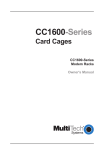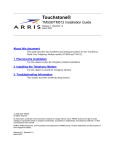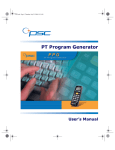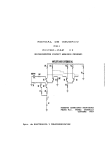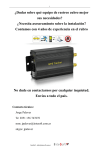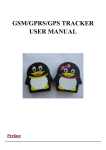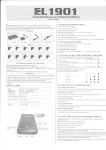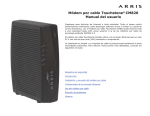Download Arris TM608 Installation guide
Transcript
Touchstone® Telephony TM608 Installation Guide ARSVD01166 Release 6 Standard 1.0 Date: December 2008 Chapter 1: Planning the Installation Use this chapter to plan the Telephony Modem installation. Chapter 2: Installing the Telephony Modem Use this chapter to install the Telephony Modem. Chapter 3: Troubleshooting Information This chapter describes troubleshooting features. © 2008 ARRIS All rights reserved Printed in the USA The information in this document is subject to change without notice. The statements, configurations, technical data, and recommendations in this document are believed to be accurate and reliable, but are presented without express or implied warranty. Users must take full responsibility for their applications of any products specified in this document. The information in this document is proprietar y to ARRIS. Protected under one or more of the following patents: 7,031,453; 7,100,011. Other patents pending or applied for. ARRIS and Touchstone are trademarks or registered trademarks of ARRIS. All other trademarks and registered trademarks are the property of their respective holders. ii Touchstone® Telephony Release 6 Standard 1.0 December 2008 Publication History December 2008 Release 6 Standard 1.0 version of this document. TM608 Installation Guide Release 6 Standard 1.0 December 2008 iv Touchstone® Telephony Release 6 Standard 1.0 December 2008 Publication History Contents Safety Requirements ....................................................................... vii Radio Frequency Emissions and Immunity ................................ ix FCC Declaration of Conformity ............................................ ix Product Safety ............................................................................ ix CE Compliance ................................................................................. ix Planning the Installation 1 Environmental Requirements ............................................................ 1 Site Location ...................................................................................... 1 Power Requirements ......................................................................... 2 Telephony Requirements ................................................................... 2 Network Requirements ...................................................................... 2 Telephony Modem Accessories ......................................................... 3 Telephony Adaptors .................................................................... 3 RJ-21X Adaptor .................................................................... 3 RJ-14/RJ-11 Adaptor ............................................................ 3 IDC Adaptor .......................................................................... 4 Wall-Mounting Kit ........................................................................ 4 Installing the Telephony Modem 5 Installation Over view ......................................................................... 5 Procedure: Inspecting and Unpacking the Telephony Modem ......... 6 Package Contents ....................................................................... 6 Procedure: Preparing the Telephony Modem ................................... 7 Requirements .............................................................................. 7 Attaching the Adaptor ................................................................. 7 Installing a Battery ...................................................................... 8 Procedure: Wall-Mounting the Telephony Modem ............................ 9 Mounting Options ........................................................................ 9 Required Tools and Materials ..................................................... 9 Spacing ....................................................................................... 9 Other Considerations .................................................................. 9 Procedure: Rack-Mounting the Telephony Modem ........................ 11 Required Tools .......................................................................... 11 Procedure: Connecting Cables ...................................................... 12 Telephone Connector Pinouts ................................................... 12 Recommendations .................................................................... 13 TM608 Installation Guide Release 6 Standard 1.0 December 2008 vi Contents Rear Panel Connectors ............................................................. 14 Subscriber Connections ............................................................ 14 Grounding Requirements .......................................................... 14 Tools .......................................................................................... 14 Troubleshooting Information 15 Front Panel LEDs ............................................................................ 15 Power-On Self Test Failure Pattern ........................................... 15 Foreign Voltage Pattern ............................................................ 15 Patterns: Normal Operation ...................................................... 17 Patterns: Star tup Sequence ...................................................... 17 MTA Star tup Sequence ...................................................... 18 CM Startup Sequence ........................................................ 18 Index Touchstone® Telephony Release 6 Standard 1.0 December 2008 19 About this Document This guide describes the installation and testing procedures for the Touchstone Multi-Line Telephony Modem models: • TM608G/NA: North American DOCSIS, 115-240V AC power; 8 telephony lines with battery backup • TM608G/CE: North Amercian DOCSIS, 115-240V AC power with European power cord; 8 telephony lines with battery backup Safety Requirements ARRIS Telephony Modems comply with the applicable requirements for performance, construction, labeling, and information when used as outlined below: CAUTION Risk of shock Mains voltages inside this unit. No user serviceable parts inside. Refer service to qualified personnel only! CAUTION Risk of damage Connecting the Telephony Modem to existing telephone wiring should be performed only by a professional wiring technician. The existing wires providing telephone service must be physically disconnected from the incumbent service provider’s network interface device. This is a physical break in the connection, not just a discontinuation of service. Failure to do so may result in damage to the Telephony Modem. TM608 Installation Guide Release 6 Standard 1.0 December 2008 viii About this Document CAUTION Risk of explosion Replacing the battery with an incorrect type, heating a battery above 75°C, or incinerating a battery, can cause product failure and a risk of fire or battery explosion. Dispose of used batteries according to the instructions. The battery used in this device may present a risk of fire or explosion when heated above 75°C or incinerated. Dispose of used battery promptly. Keep away from children. Do not dissemble or dispose of in fire. Do not locate the equipment within 6 feet (1.9m) of a flame or ignition source (e.g. heat registers, space heaters, fireplaces, etc.). Do not use product near water (i.e. wet basement, bathtub, sink or near a swimming pool, etc.), to avoid risk of electrocution. Do not use the telephone to report a gas leak in the vicinity of the leak. Avoid using and/or connecting the equipment during an electrical storm, to avoid risk of electrocution. Use only the power cord included with the equipment. Clean the equipment using a dry cloth. Avoid solvents or other chemical cleaners. Equipment should be installed near the power outlet and should be easily accessible. The shield of the coaxial cable must be connected to earth (grounded) at the entrance to the building in accordance with applicable national electrical installation codes. In the U.S., this is required by NFPA 70 (National Electrical Code) Article 820. In the European Union and certain other countries, CATV installation equipotential bonding requirements are specified in IEC 60728-11, Cable networks for television signals, sound signals and interactive services, Part 11: Safety. This equipment is intended to be installed in accordance with the requirements of IEC 60728-11 for safe operation. If the equipment is to be installed in an area serviced by an IT power line network, as is found in many areas of Norway, special attention should be given that the installation is in accordance with IEC 60728-11, in particular Annex B and Figure B.4. In areas of high surge events or poor grounding situations and areas prone to lightning strikes, additional surge protection may be required (i.e. PF11VNT3 from American Power Conversion) on the AC, RF, Ethernet and Phone lines. When the Telephony Modem is connected to a local computer through an Ethernet cable, the computer must be properly grounded to the building/residence AC ground network. All plug in cards within the computer must be properly installed and grounded to the computer frame per the manufacturer’s specifications. Touchstone® Telephony Release 6 Standard 1.0 December 2008 About this Document Radio Frequency Emissions and Immunity ix FCC Declaration of Conformity This equipment has been tested and found to comply with the limits for a Class B digital device, pursuant to part 15 of the FCC Rules. These limits are designed to provide reasonable protection against harmful interference in a residential installation. Operation is subject to the following two conditions: (1) this device may not cause harmful interference, and (2) this device may accept any interference that may cause undesired operations. This equipment generates, uses and can radiate radio frequency energy and, if not installed and used in accordance with the instructions, may cause harmful interference to radio communications. However, there is no guarantee that interference will not occur in a particular installation. If this equipment does cause harmful interference to radio or television reception, which can be determined by turning the equipment off and on, the user is encouraged to try to correct the interference by one or more of the following measures: • Reorient or relocate the receiving antenna. • Increase the separation between the equipment and the receiver. • Connect the equipment into an outlet on a circuit different from that to which the receiver is connected. • Consult the dealer or an experienced radio/TV technician for help. The FCC advises that any unauthorized changes or modifications may void the user’s authority to operate this equipment. For more information on FCC conformity, please contact: ARRIS Group, 3871 Lakefield Drive, Suite 300, Suwanee, GA 30024. This product was FCC certified under test conditions that included the use of the supplied cables between system components. To ensure compliance with FCC regulation, the user must use these cables and install them properly. Product Safety UL listed per UL60950-1. CE Compliance This product complies with the provisions of the Electromagnetic Compatibility (EMC) Directive (89/336/EEC), the Amending Directive (92/31/EEC), the Low Voltage Directive (73/23/EEC), and the CE Marking Directive (93/68/EEC). As such, this product bears the CE marking in accordance with the above applicable Directive(s). A copy of the Declaration of Conformity may be obtained by contacting: ARRIS Group, 3871 Lakefield Drive, Suite 300, Suwanee, GA 30024. TM608 Installation Guide Release 6 Standard 1.0 December 2008 x About this Document As indicated by this symbol, disposal of this product is governed by Directive 2002/96/EC of the European Parliament and of the Council on waste electrical and electronic equipment (WEEE). WEEE could potentially prove harmful to the environment; as such, upon disposal of the Telephony Modem the Directive requires that this product must not be disposed as unsorted municipal waste, but rather collected separately and disposed of in accordance with local WEEE ordinances. This product complies with directive 2002/95/EC of the European Parliament and of the Council of 27 January 2003 on the restriction of the use of certain hazardous substances (RoHS) in electrical and electronic equipment. Touchstone® Telephony Release 6 Standard 1.0 December 2008 1 Planning the Installation Use this chapter to plan the Telephony Modem installation. Environmental Requirements Provide at least 0.25 inch (6.4 mm) clearance on each side of the unit for proper ventilation and cooling. Mount the Telephony Modem properly to prevent uneven mechanical loading on the chassis. Improper mounting can cause premature failure and potentially hazardous conditions. When installed in a closed or multi-unit rack assembly, the operating temperature inside the rack environment may be higher than ambient temperature. Install the Telephony Modem in an environment where the ambient temperatures remains below 50° Celsius. Site Location Note: Install the Telephony Modem in a restricted access location. The Telephony Modem is designed to be installed in a wiring closet rack. The wiring closet must provide access to power, telephony, and network facilities as described in this chapter. The Telephony Modem can be wall-mounted using the included wall-mounting brackets. ARRIS recommends wall-mounting to a plywood surface. TM608 Installation Guide Release 6 Standard 1.0 December 2008 2 Chapter 1 Power Requirements The Telephony Modem requires 115–240V, 50/60 Hz AC power. The socketoutlet must be properly earthed. Make sure that the power circuits have sufficient capacity to power the Telephony Modem before connecting power. Telephony Requirements Each telephone line supports copper wire loop lengths of up to 128Ω, equivalent to 1000 feet (457 m) of 26 AWG (American Wire Gauge) copper wire loop. The loop length includes the cable between the Telephony Modem and punch-down block, subscriber premises wiring, and extension cables used with subscriber CPE. The Telephony Modem uses one of the following telephony connections: • cable with RJ-21X connectors to the punch-down block • RJ-14 or RJ-11 connectors • IDC rocker connectors Network Requirements If the Telephony Modem is to provide data service for subscribers, a 100BaseT Ethernet connection (usually a hub or switch) must be available. The HFC network must be DOCSIS 2.0 compatible. For best performance, use high-quality RG-6 type coax cable and minimize or eliminate splitters between the cable jack and the Telephony Modem. Touchstone® Telephony Release 6 Standard 1.0 December 2008 Planning the Installation 3 Telephony Modem Accessories ARRIS provides optional accessories for the multi-line Telephony Modems. Contact your ARRIS sales representative to order these items. Telephony Adaptors The TM608 uses modular telephony adaptors (patent pending) to connect telephone lines. The adaptors are field installable and replaceable. One of the following adaptors is required to connect telephone lines to the Telephony Modem. Choose the adapter best suited for the installation. RJ-21X Adaptor Use the RJ-21X adaptor, part number 728936, to connect the Telephony Modem to a new or existing punch-down block. RJ-14/RJ-11 Adaptor Use the RJ-14/RJ-11 adaptor, part number 728934, or the RJ-11 adaptor, part number 728935, to connect the Telephony Modem to standard telephone cables. The RJ-14/RJ-11 adaptor provides RJ-14 connectors on odd-numbered lines for use with two-line phones. TM608 Installation Guide Release 6 Standard 1.0 December 2008 4 Chapter 1 IDC Adaptor Use an IDC adaptor, part number 728937 (TII adaptor) or 728942 (Channell adaptor), to connect the Telephony Modem directly to telephone wiring. No connectors or punch-down blocks are required for use with the IDC Rocker adaptor. Channell: TII: IDC adaptors do not require wire stripping or tools. Wall-Mounting Kit The wall-mounting kit, part number 729864, includes wall-mount brackets and the screws required to attach the brackets to the Telephony Modem. Screws required to secure the Telephony Modem to the rack are not included. Touchstone® Telephony Release 6 Standard 1.0 December 2008 2 Installing the Telephony Modem Use this chapter to install the Telephony Modem. CAUTION Installation only by trained personnel The TM608 is intended only for installation by wiring technicians and other trained personnel. Installation Overview Perform the following procedures to install the TM608. Procedure Inspecting and Unpacking the Telephony Modem Preparing the Telephony Modem Wall-Mounting the Telephony Modem Rack-Mounting the Telephony Modem Connecting Cables Page 6 7 9 11 12 Note: Tabletop usage is recommended only for lab trials rather than general deployment. TM608 Installation Guide Release 6 Standard 1.0 December 2008 6 Chapter 2 Inspecting and Unpacking the Telephony Modem Use this procedure to ensure the Telephony Modem package contains all the required components, and that the unit is not damaged. Package Contents The TM608 package contains the following items: 1 Telephony Modem 2 Power cable 3 Three bar-coded MAC address labels 4 Wall-mounting brackets and screws 5 End-User License Agreement (EULA) 6 Battery (optional) Note: If any items are missing, call your ARRIS sales representative for replacements. If the contents appear to be damaged, file a claim with the shipping company. Action Follow these steps to inspect and unpack the Telephony Modem. 1 Before opening the box, visually inspect the package for visible damage. Note: If the package shows visible signs of damage, contact the shipping company for instructions. Do not open a damaged package before consulting the shipping company. 2 If the package is undamaged, open the box at the top. 3 Lift the Telephony Modem bag out of the package. 4 If all the items are present and undamaged, affix the MAC address stickers where they can be seen after installation. Touchstone® Telephony Release 6 Standard 1.0 December 2008 Installing the Telephony Modem 7 Preparing the Telephony Modem Before installing the Telephony Modem, use this procedure to install required and optional accessories. Requirements You need the following items to attach an adaptor: • RJ-14/RJ-11 adaptor, RJ-21X adaptor, or IDC Rocker adaptor • Two screws (included with the adaptor) • Small flat-blade screwdriver Action Perform the following tasks as needed. Task Page Attaching the Adaptor Installing a Battery Attaching the Adaptor 7 8 The TM608 uses one of three adaptors to attach telephone lines. Follow these steps to attach the adaptor. 1 If an adaptor different from the required adaptor is already attached to the TM608, remove the two screws and remove the adaptor from the back of the TM608. 2 Align the pins on the adaptor with the sockets on the Telephony Modem, and orient the label on the adapter with the top of the Telephony Modem, and push the adaptor into place. 3 Secure the adaptor using the two screws included with the adaptor. TM608 Installation Guide Release 6 Standard 1.0 December 2008 8 Installing a Battery Chapter 2 The TM608 has a battery bay in the front panel. You can install a battery in the bay to provide power to the TM608 in case of a AC power outage. Follow these steps to install the backup battery. 1 Pull the battery door latch toward the center of the Telephony Modem and remove the battery door. Set the battery door aside. 2 If necessary, remove the existing battery. Some batteries have a pull strap as shown in the example below. 3 Insert the backup battery as shown below. Depending on the battery capacity, the actual battery may differ from that shown. 4 Replace the battery door: a Insert the battery door tab into the slot in the right side of the battery bay. b Swing the battery door closed and press gently until it latches. Touchstone® Telephony Release 6 Standard 1.0 December 2008 Installing the Telephony Modem 9 Wall-Mounting the Telephony Modem Use this procedure to mount the Telephony Modem on a wall or other vertical surface. Note: For rack-mounting instructions, see ‘‘Rack-Mounting the Telephony Modem’’ on page 11. Rack-mounting requires the optional rack-mounting bracket kit. Mounting Options For best results, ARRIS recommends mounting the Telephony Modem to one of the following surfaces: • Plywood or studs, using wood screws. • Drywall, using drywall anchors. • Concrete, using concrete anchors. The mounting surface must be flat and even to avoid warping or damaging the Telephony Modem enclosure when tightening the screws. Damage due to improper installation is not covered under warranty. Required Tools and Materials For wall-mounted installations, make sure you have the following tools and materials before proceeding: • For mounting on drywall: – Two 1/4 (6mm) drywall anchors (not included) – A drill with 1/4 (6mm) bit (not included) • For mounting on plywood or studs: – Two #6 x 1.5 (38.1 mm) self tapping screws (not included) – Screwdriver (flat-blade or Phillips, depending on what kind of screws you use) (not included) • Mounting brackets and screws required to attach the brackets to the Telephony Modem (included). Spacing With wall-mount brackets attached, the mounting holes are spaced 13.5 in (343 mm) apart. TM608 Installation Guide Release 6 Standard 1.0 December 2008 10 Other Considerations Chapter 2 Make sure the intended mounting location has an AC receptacle (socket-outlet) nearby. The power cord must be able to reach the outlet without stretching or being run through openings in walls, ceilings, or floors. Do not attach the power cord to the mounting surface or other building surfaces. Action Follow these steps to wall-mount the Telephony Modem using the provided wall-mounting brackets. 1 Install one wall-mount bracket on each side of the Telephony Modem so that the long flat side contacts the chassis and the brackets protrude away from the bottom edge of the chassis, as shown below. Use four screws to fasten each bracket to the Telephony Modem. Note: Position the brackets so the bottom of the chassis will be against the mounting surface. This position leaves the serial number label exposed, and orients the front panel for best readability. 2 Make two marks, spaced horizontally, 13.5 inches (343 mm) apart, on the mounting surface. 3 For drywall or concrete surfaces: a Insert the mounting anchors into the wall, according to the directions provided with the anchors. b Remove the mounting screws, leaving the anchors in place. 4 Lift the Telephony Modem into place on the wall and secure it using the mounting screws. Touchstone® Telephony Release 6 Standard 1.0 December 2008 Installing the Telephony Modem 11 Rack-Mounting the Telephony Modem Use this procedure to mount the Telephony Modem in a 19-inch rack. For wall-mounting, see ‘‘Wall-Mounting the Telephony Modem’’ on page 9. Required Tools To rack-mount the Telephony Modem, you need: • #2 and #1 Phillips screwdrivers • The optional rack-mounting bracket kit, part number 729864. • Four screws to attach the unit to the rack. Action Follow these steps to rack-mount the Telephony Modem. 1 Install one rack mounting bracket on each side of the Telephony Modem so that the smooth side contacts the enclosure and the brackets protrude away from the front edge of the unit as shown below. Use four screws to fasten each bracket to the Telephony Modem. 2 Mount the Telephony Modem in the rack and secure it using two screws on each side. TM608 Installation Guide Release 6 Standard 1.0 December 2008 12 Chapter 2 Connecting Cables Use this procedure to connect the Telephony Modem to power and networks. Telephone Connector Pinouts The Telephone connector provides 8 lines of POTS (2-wire) telephone service. Three adaptors are available: • The RJ-21X adaptor connects the Telephony Modem to a punch-down block. The following diagram shows the pinout of the RJ-21X telephone connector. 1 RNG01 27 2 RNG02 TIP03 28 3 RNG03 TIP04 29 4 RNG04 TIP05 30 5 RNG05 TIP06 31 6 RNG06 TIP07 32 7 RNG07 TIP08 33 8 RNG08 TIP09 34 9 RNG09 TIP10 35 10 RNG10 TIP11 36 11 RNG11 TIP12 37 12 RNG12 38 13 39 14 40 15 41 16 42 17 43 18 44 19 45 20 46 21 47 22 48 23 49 24 50 25 Touchstone® Telephony Release 6 Standard 1.0 December 2008 G2 26 TIP02 G1 TIP01 Installing the Telephony Modem 13 • The RJ-14/RJ-11 adaptor provides 8 telephone jacks. The following diagrams show the pinouts of RJ-14 and RJ-11 connectors. Jack Pin Color Signal 123456 1 2 3 4 5 6 n/c n/c Red Green n/c n/c n/c n/c Ring Tip n/c n/c 123456 1 2 3 4 5 6 n/c Black Red Green Yellow n/c n/c Line 2 Tip Line 1 Ring Line 1 Tip Line 2 Ring n/c RJ-11: RJ-14: • The IDC adaptor provides rocker-style connections to connect telephone wires to the Telephony Modem without using tools. To use the IDC adaptors, open the clip, insert the tip wire in the white hole, and the ring wire in the orange hole, and snap the clip closed. Recommendations For best performance, use high-quality RG-6 type coax cable and minimize or eliminate splitters between the cable jack and the Telephony Modem. TM608 Installation Guide Release 6 Standard 1.0 December 2008 14 Rear Panel Connectors Chapter 2 Refer to the following photo for the locations of rear panel connectors when performing this procedure. 1 Telephony adaptor jacks 2 Ethernet connector 3 Network RF (coax) connector 4 AC power connector Subscriber Connections If the Telephony Modem is intended to provide data services, Ethernet lines from subscriber units must be run to a switch or hub in the wiring closet. The switch or hub must have at least one free connection for the Telephony Modem. Grounding Requirements The coax ground should be tied to AC building ground per NFPA 70 (National Electrical Code) Article 820 requirements. Tools A torque-limiting wrench can be used to secure RF cables. Action Follow these steps to connect cables to the Telephony Modem. 1 If a telephony adaptor is not already connected to the TM608, install it as described in ‘‘Preparing the Telephony Modem’’ on page 7. 2 Connect the RF cable to the Network RF connector, and tighten to a torque pressure of 17 to 23 Kg-cm (15 to 20 in-lb.). Note: If a torque-limiting wrench is not available, tighten the connector by hand, then tighten a further 1/8 to 1/4 turn with a wrench. 3 (optional) Connect a 100BaseT Ethernet cable between the Telephony Modem Ethernet jack and the Uplink port on a hub or switch. 4 Connect the power cord between the AC connector on the Telephony Modem and the AC power source. 5 Connect telephony cables as appropriate for the installed adaptor. Touchstone® Telephony Release 6 Standard 1.0 December 2008 3 Troubleshooting Information This chapter describes troubleshooting features. Front Panel LEDs The front panel LEDs provide information about DOCSIS and telephony status. The LED patterns shown in this section are valid for the default firmware version installed on the Telephony Modem. See the Troubleshooting Guide corresponding to the actual firmware installed for updated LED patterns. Power-On Self Test Failure Pattern When a Telephony Modem fails power-on self test (POST), it repeats the following sequence: • POWER LED on for 2 seconds; other LEDs off • All LEDs flash rapidly (10 times per second) for 10 seconds A Telephony Modem repeatedly displaying this sequence is defective and should be replaced. TM608 Installation Guide Release 6 Standard 1.0 December 2008 16 Foreign Voltage Pattern Chapter 3 If the Telephony Modem detects a foreign voltage on one or more telephone lines, it repeats the following sequence: • All LEDs on • The LED corresponding to the telephony line(s) with foreign voltage If you see this sequence, immediately disconnect the affected lines and eliminate the voltage source. Common sources of foreign voltage include: • connection to incumbent telephone service • shorted wires • defective CPE Note: All telephony lines must be physically disconnected from incumbent service before connecting the lines to the Telephony Modem. Cancellation of incumbent service is not sufficient. Touchstone® Telephony Release 6 Standard 1.0 December 2008 Troubleshooting Information Patterns: Normal Operation Operating Mode AC Power Good Power On 17 The following table shows LED patterns for the Telephony Modem during normal operation. DS US On = Online On = Online Flash = Off-line Flash = Off-line Online Link On = network available On = CPE connected Tel. 1 – 8 On = On-hook Flash = Off-hook Off = CPE disconnected Off = network not available Flash = CPE activity1 Slow Flash2 = Line card error Off = disabled On = On-hook Flash = Off-hook AC Power Fail Flash Off Off Off Off Slow Flash = Line card error Off = disabled Firmware Upgrade Line Card Protection State4 x3 Flash Flash On x x Flash Flash Flash Flash Flash Flash Off Off Off Off Off (line) 1. This state is valid only if the Telephony Modem is online. 2. Slow Flash is 1 flash per second. 3. An x indicates the LED state reflects the ‘‘AC Power Good’’ or ‘‘AC Power Fail’’ status. 4. Line Card Protection indicates foreign voltage present on one or more lines. In this state, the LED pattern alternates between all LEDs flashing and only the Telephony LEDs corresponding to the line or lines where the fault was detected. TM608 Installation Guide Release 6 Standard 1.0 December 2008 18 Patterns: Startup Sequence Chapter 3 The following tables show LED patterns for the Telephony Modem during each phase of the startup sequence. MTA Startup Sequence If the MTA fails to complete registration, note the LED pattern and call your next level of support. Step 0 1 2-4 5 6 7 Description Power, DS, US, Online No Power Off Self-Test Flash CM Initialization; see ‘‘CM Startup Sequence’’ below. Telephony DHCP On Telephony SNMP/TFTP On Telephony RSIP On Link Telephone Off Flash Off Flash Off Off On On On Flash Off Flash MTA Normal Operation CM Startup Sequence If the modem fails to complete registration, note the LED pattern and call your cable operator for assistance. Step Description DS US Online Link 2 3 4 Downstream scan/sync Upstream ranging DOCSIS DHCP/TFTP Flash On On Off Flash On Off Off Flash Off Off Off CM Normal Operation Touchstone® Telephony Release 6 Standard 1.0 December 2008 4 Index L A AC power 2 connecting 14 accessories 3 adaptor, attaching 7 attaching the adaptor 7 B battery, installing 8 bracket, rackmount 10–11 C cable torque, RF 14 CM startup sequence, LED patterns 18 connecting AC power 14 connection Ethernet 2 RF 2 connector, pinouts, telephone 12 connectors, rear panel 14 considerations, data service 14 contents, package 6 D damage, in case of 6 data service considerations 14 E environmental requirements 1 Ethernet connection 2 F foreign voltage pattern 16 front panel LEDs 15 G grounding requirements 14 I in case of damage 6 inspection, unpacking and 6 installing a battery 8 LED patterns CM startup sequence 18 MTA startup sequence 18 normal operation 17 LEDs, front panel 15 length, maximum loop 2 location, site 1 loop length, maximum 2 M maximum loop length 2 mounting rack 11 tabletop 5 wall 9 MTA startup sequence, LED patterns 18 N network requirements 2 normal operation, LED patterns 17 P package contents 6 panel connectors, rear 14 LEDs, front 15 pattern, foreign voltage 16 patterns CM startup sequence, LED 18 MTA startup sequence, LED 18 normal operation, LED 17 pinouts RJ-21X 12 telephone connector 12 power AC 2 connecting AC 14 requirements 2 power-on self test 15 R rack mounting 11 rackmount bracket 10–11 rear panel connectors 14 requirements environmental 1 grounding 14 network 2 TM608 Installation Guide Release 6 Standard 1.0 December 2008 20 Chapter 4 power 2 telephony 2 RF cable torque 14 connection 2 RJ-21X, pinouts 12 S self test, power-on 15 service considerations, data 14 site location 1 startup LED patterns, CM 18 LED patterns, MTA 18 T tabletop mounting 5 telephone connector, pinouts 12 telephony requirements 2 torque, RF cable 14 troubleshooting 15 U unpacking and inspection 6 V voltage pattern, foreign 16 W wall mounting 9 Touchstone® Telephony Release 6 Standard 1.0 December 2008 Touchstone® Telephony TM608 Installation Guide © 2008 ARRIS All rights reserved Printed in the USA The information in this document is subject to change without notice. The statements, configurations, technical data, and recommendations in this document are believed to be accurate and reliable, but are presented without express or implied warranty. Users must take full responsibility for their applications of any products specified in this document. The information in this document is proprietar y to ARRIS. Protected under one or more of the following patents: 7,031,453; 7,100,011. Other patents pending or applied for. ARRIS and Touchstone are trademarks or registered trademarks of ARRIS. All other trademarks and registered trademarks are the property of their respective holders.
































